| Home |
| Acknowledgments |
| Conventions |
| Glossary |
| Maps |
| References |
| Links |
| Articles |
| Thumbnails |
| Species
list |
| Family |
| Next
species |
Additional Photos
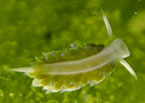
underside

side

front

cardiac sack

rhinophore swellings

young
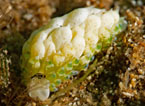
faded

regeneration error
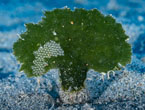
on alga
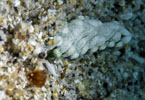
burying
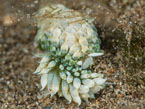
mating

with egg mass
_______________

Costasiella fridae Fernández-Simón & Moles, 2023
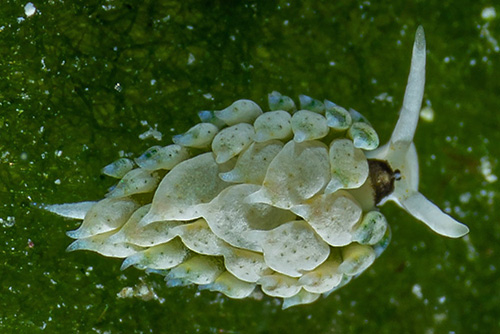
| Maximum size: about 12 mm. Identification: This species has an opaque-white body. The cerata are mottled-green basally grading to opaque-white with a few translucent spots (elevated?) apically. The tips of the lateral cerata are tinged with blue. The rhinophores have translucent-cream tips and bases. There is a translucent-cream patch in front of the eye spots and an oval black patch behind them. Some animals may have a few flecks of brown in front of the eye spots and a few white flecks on the translucent rhinophore tips. Young animals may have less white pigment. The rhinophores may show a central bulge when contracted. Natural history: Costasiella fridae is known from numerous animals found on its host algae (Avrainvillea erecta) at 5-30 m (15-100 ft), sometimes in association with Costasiella kuroshimae and/or Costasiella sp. #3. (see photos) It lays a compact, spiral, translucent egg mass and may bury itself partially in sand when not on its food algae. (Note 1) (Note 2) Distribution: Big Island, Maui, Oahu and Kauai: probably widely distributed in the Indo-Pacific. Taxonomic notes: It may have been first recorded in Hawaii from Honokohau Harbor, Big Island by Rachel Schackne in Oct., 2019. (Note 3) It may turn out to be "Costasiella sp. 1" as illustrated in Gosliner, et. al. 2018. Since its food algae, Avrainvillea erecta, is thought to be introduced there's some chance that this species is, as well. (Note 4) It was formerly listed on our site as "Costasiella sp. #2." Photo: Marketa Murray: about 5 mm: found by Christian Hamilton & Marketa Murray; Honokohau Harbor, Big Island; May 17, 2020. Observations and comments: Note 1: Marketa Murray reported that she found about 6 different blades of Avrainvillea erecta about 2 m apart in an area of about 20 square meters on each of two dives in a low density Halimeda kanaloana bed. She found 5-8 animals on each blade at around 9:00 AM and 3-5 animals on each blade at around 12:00 PM. It was a sunny day with 50-100 ft visibility. Note 2: Rich Neely found two large animals in a patch of Halophila decipiens at 15 m (49 ft). Rich reports that they were "...motionless with their heads buried in the sand. I thought I was seeing things so I gave one a gentle lift and it started to move around, very camera shy as I followed its circles until it decided to bury its head again and become motionless again. This happened several times." There was no Avrainvillea erecta in the vicinity. Perhaps, they had exhausted available food and were searching for more. Perhaps, they drifted into the Halophila patch... Note 3: Pam Madden, Marketa Murray and Christian Hamilton were the first to send us photos and data for this species. Subsequent to uploading the page, Marc Hughes sent us his photos, some predating theirs (earliest, Oct. 31, 2019). However, he said that he was shown the animals by Rachel Schackne in October and that there may be other photos that predate his. He also forwarded one of Rachel's photos indicating that she knew the animal. But, it lacked a "date taken" tag so we're giving her a tentative credit pending confirmation with a securely dated photo (we usually use a "first clear evidence" standard for determining priority). If we receive any photos that predate Marc's and Rachel's, (it appears to be a popular dive site...) we'll change the credit, accordingly. Please let us know if you have any. Note 4: Costasiella fridae is very similar to Costasiella sp. #1 in it's head markings. It differs from that species in having few or no iridescent flecks, largely continuous white pigment rather than white flecks, larger central cerata with translucent spots (pustulate?) and bluish cerata tips confined to the lateral cerata. We opted to split the two based on those differences. Costasiella sp. #1 is found in shallow rocky habitats where it almost certainly isn't eating Avrainvillea erecta and is probably exposed to more surge. This may reinforce the evidence for the split. But, it can't be ruled out that the two represent different forms that a single species assumes in response to differences in diet and habitat. Hence, the split will really require DNA work for final confirmation. Most "black mask" photos from elsewhere in the Indo-Pacific seem closer to this species than to C. sp. #1. |
| Thumbnails |
Species
list |
Family | Next species | Top |